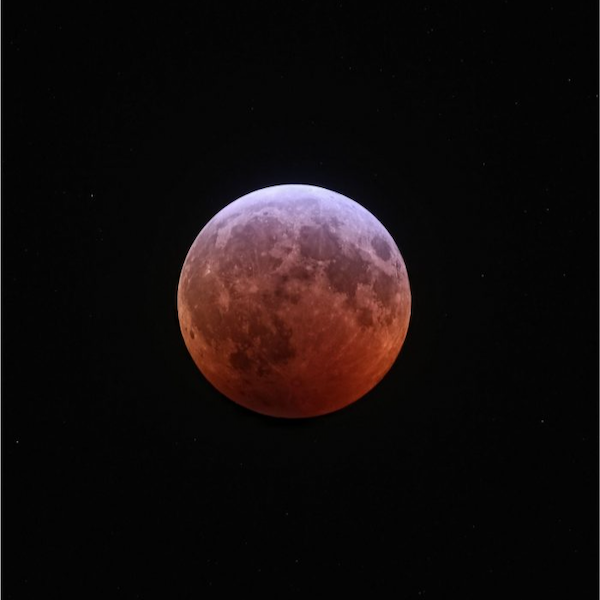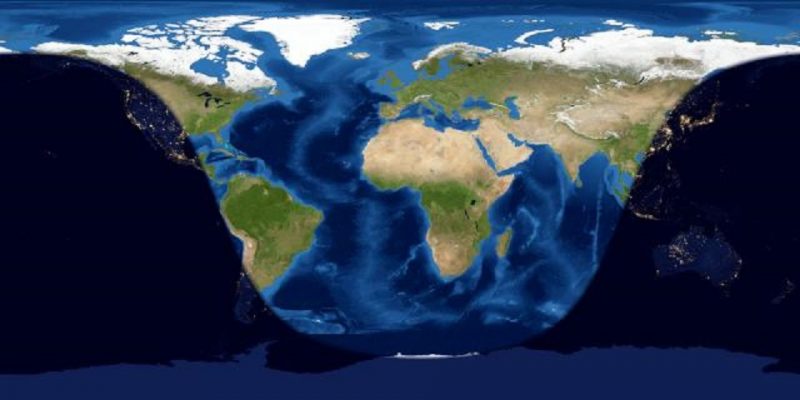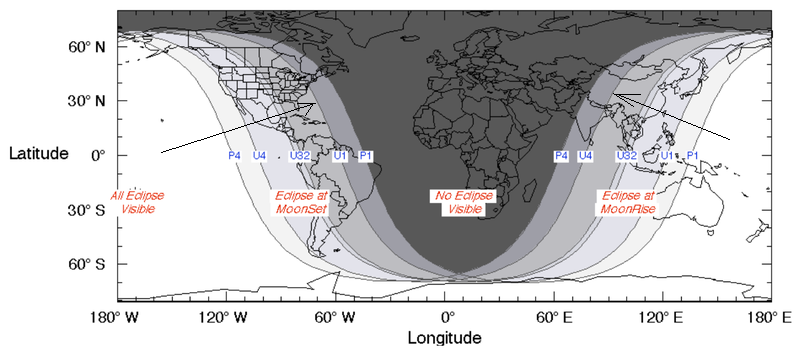
On May 26, 2021, the full moon will sweep through the Earth’s dark umbral shadow, creating a total eclipse of the moon. This May full moon is 2021’s closest (and therefore biggest and brightest) full moon of the year: a supermoon. The eclipse will take place in the early morning hours, before sunrise, for those in western North America and at other times for people elsewhere on the globe. This particular eclipse is also special because the totality, or total phase, is so short-lived, lasting less than 15 minutes.
Total eclipses of supermoons aren’t all that rare. The last total eclipse of a year’s closest full moon happened on September 28, 2015.
Although the totality in the May 26, 2021, eclipse lasts for less than 15 minutes, a partial umbral eclipse precedes and then follows totality by nearly 1 1/2 hours each time. So, from start to finish, the moon takes a little over three hours to pass through the Earth’s dark shadow. Plenty of time to enjoy, especially under a dark sky.

Who will see the total eclipse?
As always, you have to be in the right place to see this eclipse. The May 26 eclipse is visible from western North America, southern and far-western South America, the Pacific Ocean, New Zealand, Australia and southeast Asia.
From the Americas, this eclipse takes place in the early morning hours before sunrise May 26. From the world’s Eastern Hemisphere (New Zealand, Australia and southeast Asia), the eclipse happens in the evening hours after sunset May 26. The worldwide map above helps to explain.
A swath of the Americas to the right (east) of the sunrise line on the worldwide map will miss the total eclipse but can watch a partial umbral eclipse of the moon; whereas a section of Asia to the left (west) of the sunset line will miss the total eclipse but can watch a partial umbral eclipse. The arrows in the worldwide map below show where the umbral eclipse begins in the Americas and where the umbral eclipse ends in Asia. The regions marked U4 to P4 in Asia, and U1 to P1 in the Americas, sit outside the umbral eclipse viewing area. So this outlier region must be content with a faint penumbral eclipse.

Eclipse times in UTC (May 26, 2021)
We give the eclipse times first in UTC (Coordinated Universal Time, same as GMT) and then in local time for U.S. time zones:
Partial umbral eclipse begins: 09:45 UTC
Total eclipse begins: 11:11 UTC
Greatest eclipse: 11:19 UTC
Total eclipse ends: 11:26 UTC
Partial umbral eclipse ends: 12:52 UTC
Eclipse times for North American time zones:
Eastern Daylight Time (May 26, 2021)
Partial umbral eclipse begins: 5:45 a.m. EDT
Total eclipse begins: 7:11 a.m. EDT
Greatest eclipse: 7:19 a.m. EDT
Total eclipse ends: 7:26 a.m. EDT
Partial umbral eclipse ends: 8:52 a.m. EDT
Central Daylight Time (May 26, 2021)
Partial umbral eclipse begins: 4:45 a.m. CDT
Total eclipse begins: 6:11 a.m. CDT
Greatest eclipse: 6:19 a.m. CDT
Total eclipse ends: 6:26 a.m. CDT
Partial umbral eclipse ends: 7:52 a.m. CDT
Mountain Daylight Time (May 26, 2021)
Partial umbral eclipse begins: 3:45 a.m. MDT
Total eclipse begins: 5:11 a.m. MDT
Greatest eclipse: 5:19 a.m. MDT
Total eclipse ends: 5:26 a.m. MDT
Partial umbral eclipse ends: 6:52 a.m. MDT
Pacific Daylight Time (May 26, 2021)
Partial umbral eclipse begins: 2:45 a.m. PDT
Total eclipse begins: 4:11 a.m. PDT
Greatest eclipse: 4:19 a.m. PDT
Total eclipse ends: 4:26 a.m. PDT
Partial umbral eclipse ends: 5:52 a.m. PDT
Alaskan Daylight Time (May 26, 2021)
Partial umbral eclipse begins: 1:45 a.m. AKDT
Total eclipse begins: 3:11 a.m. AKDT
Greatest eclipse: 3:19 a.m. AKDT
Total eclipse ends: 3:26 a.m. AKDT
Partial umbral eclipse ends: 4:52 a.m. AKDT
Hawaiian Standard Time (May 25-26, 2021)
Partial umbral eclipse begins: 11:45 p.m. HST (May 25, 2021)
Total eclipse begins: 1:11 a.m. HST (May 26, 2021)
Greatest eclipse: 1:19 a.m. HST
Total eclipse ends: 1:26 a.m. HST
Partial umbral eclipse ends: 2:52 a.m. HST
Find out the eclipse times for your part of the world via timeanddate.com, remembering to place your city in the lookup box.

Why such a short total lunar eclipse?
A total lunar eclipse can only happen at full moon, or when the moon is opposite the sun in Earth’s sky. More often than not, however, the full moon passes to the north or to the south of Earth’s dark shadow, and therefore avoids being eclipsed. For instance, last month – on April 27 – the full moon swept to the north of the Earth’s shadow; whereas next month – on June 24 – the full moon will swing to the south of Earth’s shadow.
In fact, the full moons of July, August, September and October 2021 will all travel south of the Earth’s shadow. Finally, the November 2021 full moon will meet up with the Earth’s dark shadow on November 19, 2021. It won’t be a perfect alignment, however, and the November full moon will just miss being totally eclipsed.
Yet, the total lunar eclipse on May 26, 2021, doesn’t make a perfect alignment, either. In fact, this May 2021 full moon doesn’t even cross the center of the Earth’s shadow. This full moon is about as far as it can get from the center of the Earth’s shadow and still be totally eclipsed. That’s why this total eclipse lasts for a short period of time, less than 15 minutes.
The more closely that the full moon’s center aligns with the center of the Earth’s shadow, the deeper and longer the total eclipse. On July 27, 2018, the alignment between full moon and Earth’s shadow was almost perfect, to produce the longest total lunar eclipse of the 21st century (2001 to 2100). This total eclipse lasted for 1 hour and 43 minutes, or nearly 1 1/2 hours longer than the May 26, 2021, eclipse.
Read May-June 2021: A special pair of eclipses
Read more: Century’s longest lunar eclipse July 27, 2018

Eclipse timings for the telescope
Crater and limb contacts for the 2021 May 26 total lunar eclipse via Helio C Vital
Eclipse-Timing Predictions for the May 26 Total Lunar Eclipse via Sky & Telescope
Bottom line: The total eclipse of 2021’s closest supermoon on May 26 is a rather shallow one. But it’s 2021’s only total lunar eclipse and the first such eclipse to take place since January 21, 2019. It’ll be visible from western North America, southern and far-western South America, the Pacific Ocean, New Zealand, Australia and southeast Asia. Enjoy it while the time is at hand!











